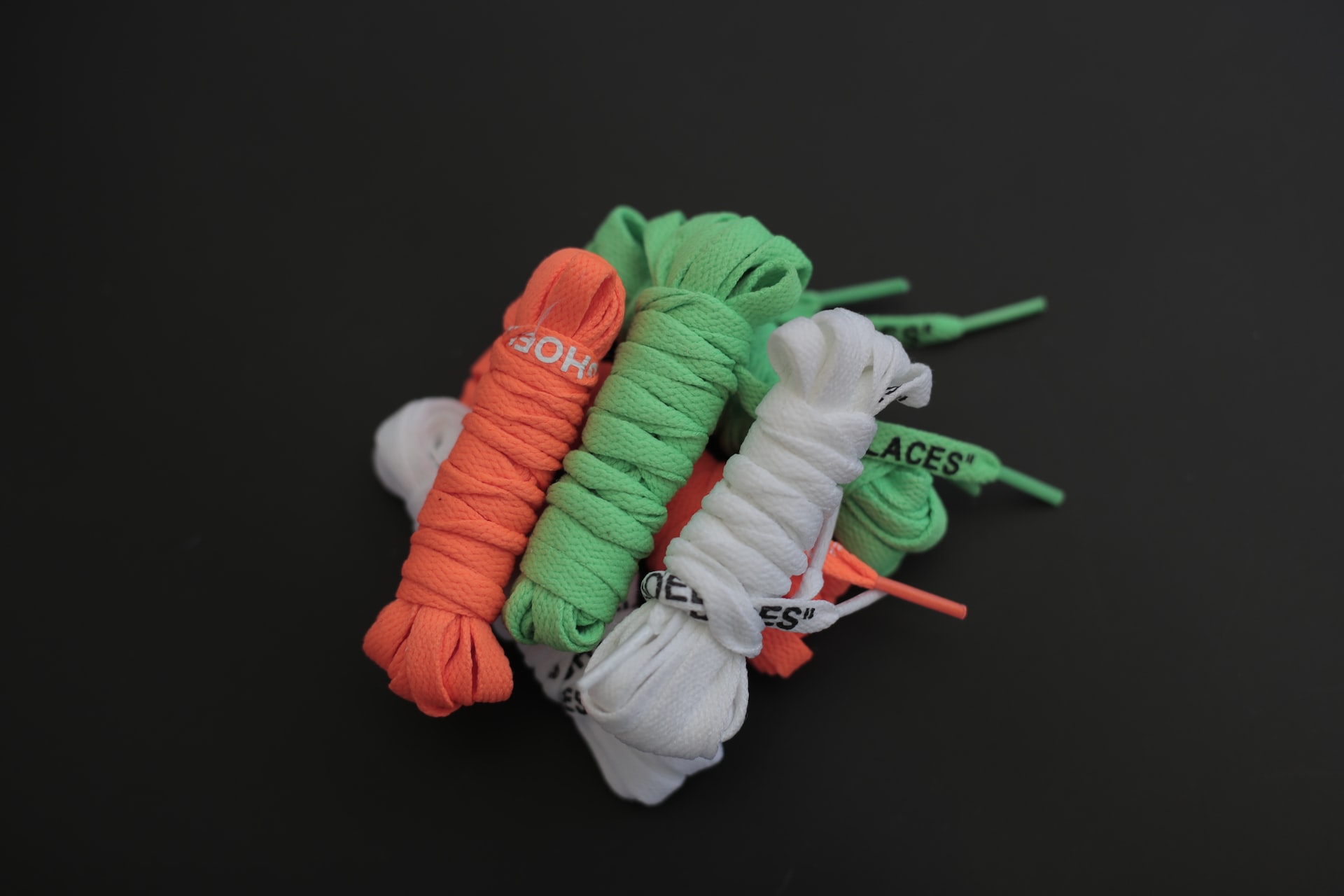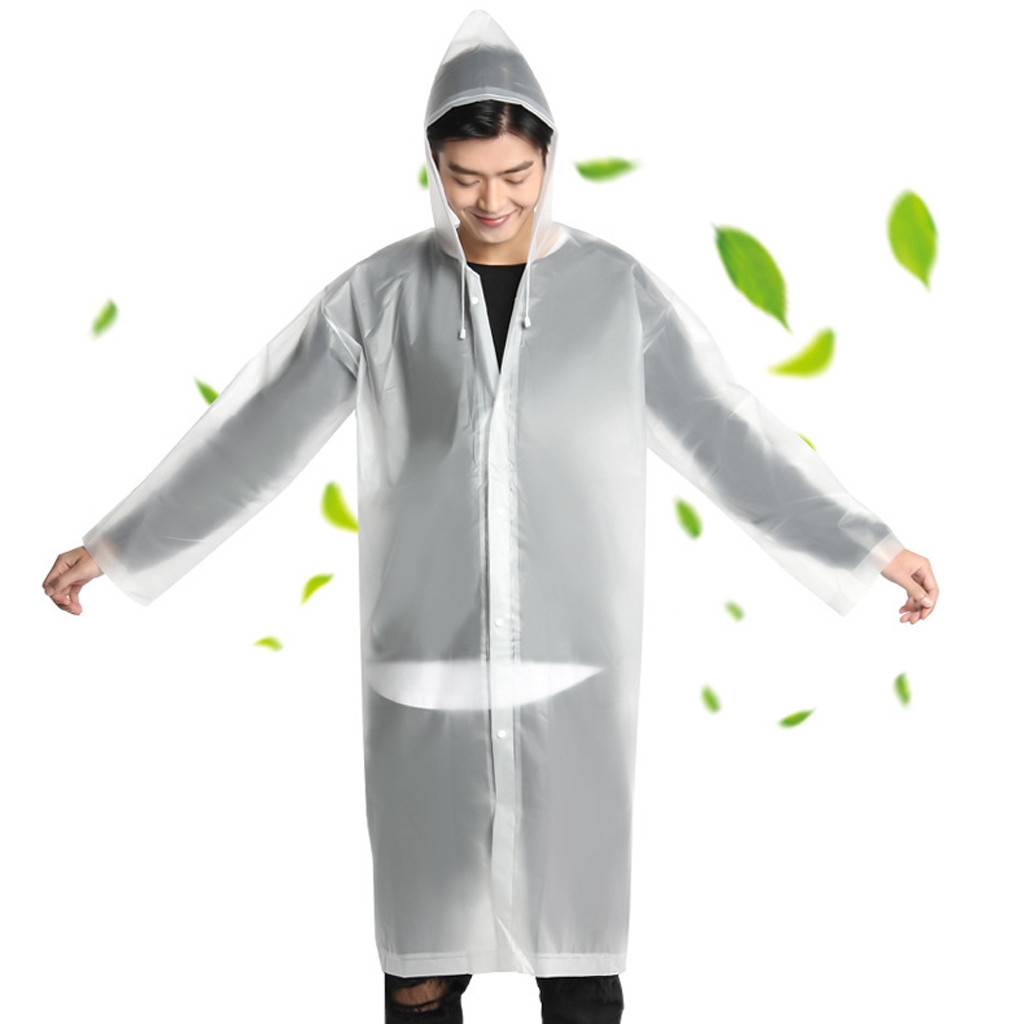Rating of the best Austin rose varieties for 2022
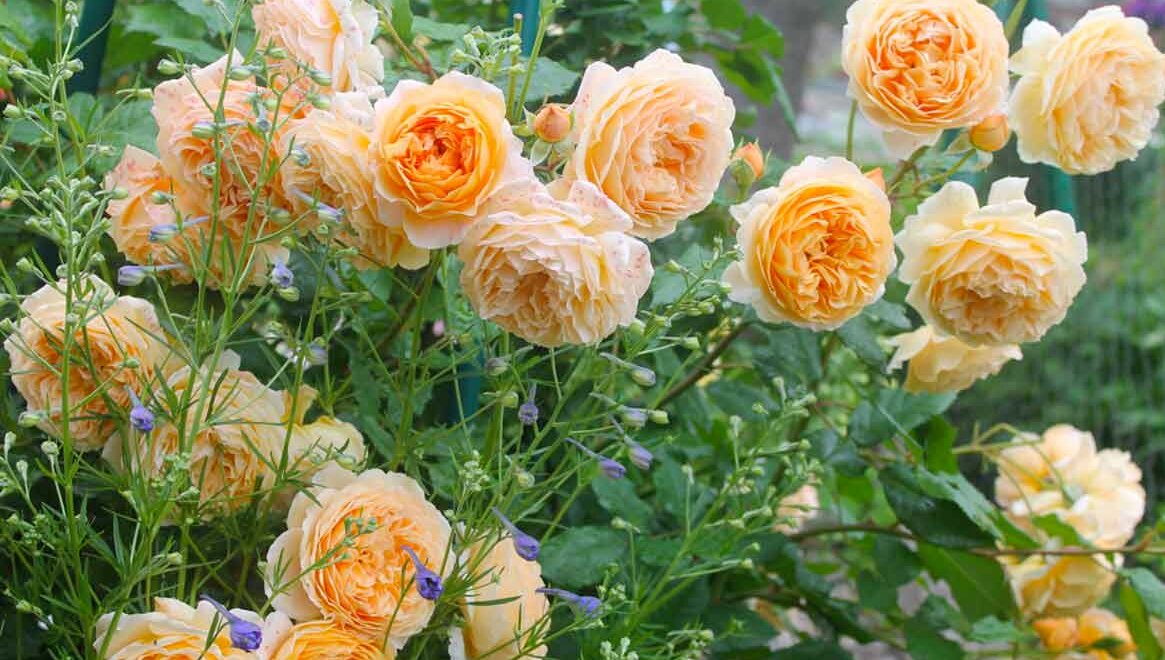
Roses are the queen of flowers and come in a variety of colors and sizes. Studying the rating of the best varieties of Austin roses for 2022, you can choose a new specimen for a rose garden, collection, or start growing from a novelty.
Content
What are
David Austin is an English breeder who developed new varieties of roses by crossing Floribunda, hybrid tea and old varieties.
New varieties appeared in the 80s of the 20th century. They are not distinguished into a separate class, they belong to English roses, scrubs (bush types).Other names are Austin roses, Austin roses. The number of hybrids bred is more than 200.
Main differences
David Austin selected plants with certain criteria:
- The bud is rosette, pump-shaped, cup-shaped.
- Intense aroma - the intensity changes in the morning, evening hours, depending on weather conditions (sunny, cloudy weather).
- The bush is round, tall or medium, the shoots are straight or hanging down.
Other varieties of buds: bowl (shallow, deep, open), reverse-curved, cruciform rosette.
The number of petals is from 40 to 200, there is a velvet effect.
There are five types of fragrance: musk, myrrh, fruity, tea and old roses. Most species combine several types into one, change strength at different times.
The necessary criteria were selected from mother plants:
- color (the appearance of yellow, wine colors) - tea-hybrid;
- pleasant smell (berry, fruity, citrus) against the background of vintage;
- repeated, undulating appearance of new buds, an inflorescence of 5-10 pieces - floribunda.
Peculiarities
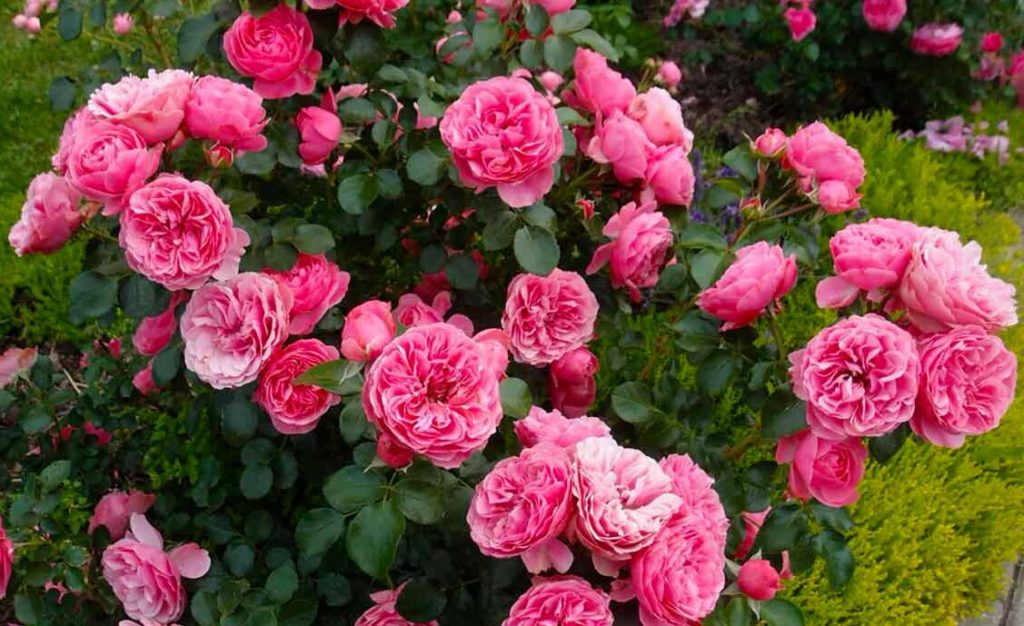
Austins have advantages over other flowering perennials that are easy to maintain with proper care:
- Abundant flowering all summer and autumn (without interruption or undulating).
- Can be planted in semi-shady, shady places.
- There is no overgrowth if the plant is planted correctly (the neck is deepened by 3-4 cm).
- Rarely suffer from fungal diseases.
- Can be used for different purposes (cutting, mixed plantings, decorating fences, arbors).
Disadvantages that appear if the plant is planted incorrectly, the wrong place is chosen:
- small size, burnt color - bright sun for a long time;
- a large amount of precipitation - the buds do not fully open;
- not abundant re-flowering - little fertilizer;
- thin shoots can bend towards the ground.
How to choose, care
Seedlings can be bought in stationary nurseries, rose gardens, online stores. The cost will depend on the age of the seedling, the type of root system (closed or open), the type of rootstock.
Austin rootstock is carried out on Rosa laxa (white roots), which does not produce wild shoots when properly planted. Rootstock Rosa canina (dog rose) produces a lot of shoots that need to be cut right from the root.
Landing
When planting a plant, you need to follow certain steps:
- Choose high-quality material (preferably with a closed root system), according to reviews from trusted sellers.
- Choose a place - sunny, well-ventilated, spacious.
- Dig a hole (30-40 cm deep, 40-50 cm wide).
- Spill 4-5 liters of water until completely absorbed.
- Be sure to pour a drainage layer (fine gravel, tile particles).
- Gently spread the earthen ball, fill it with nutrient soil.
- If the root system is closed - do not distribute the roots, plant them together with a lump.
- If the roots are without soil - cut by a third, soak in water, you can add a rooter to the water, or sprinkle before planting.
The graft should be covered with 4-5 cm of soil. After landing - shed 3-4 liters of water.
Planting time - spring (warmed soil up to + 7-9⁰С) end of April and beginning of May for the Moscow region, the middle zone. In warm areas, Crimea can be planted in autumn (mid-September to early November) - before the first frost (the plant should take root well).
top dressing
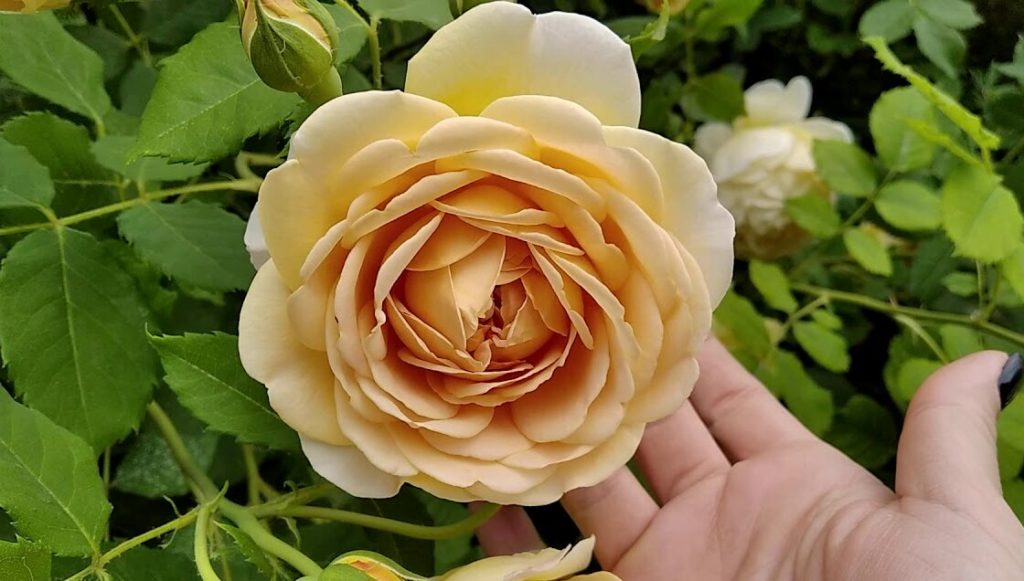
In spring, nitrogen-containing fertilizer complexes are relevant - the rapid growth of shoots and leaves. For good flowering - complexes containing potassium, phosphorus.
It is better to dissolve all dressings in water, shed them after abundant watering (the roots can burn if not watered before fertilizing). Stop feeding any species from August.
Under stressful conditions (lack of moisture, cooling, heat, prolonged rains), sodium humate, epin, zircon can be used.
pruning
Pruning (Russian conditions) is desirable in early spring, when you can see which shoots have frozen. Be sure to use a sharp quality pruner.
Cutting conditions:
- Cut out small, thin shoots.
- Remove all branches growing inside the bush.
- For a spreading bush, cut off the tips (4-6 cm).
- Climbing view - keep the main long shoots, remove the inner, small ones.
- Compact - cut two-thirds, leaving 4-7 main shoots.
Re-setting buds - remove faded buds in time.
Detailed pruning instructions can be found on YouTube channels.
Extra Care
Watering - 4-5 liters of not cold water for each bush. The frequency of watering depends on the temperature, the amount of precipitation (usually - 1 time in 7-10 days, hot weather - 1 time in 3-4 days).
Mandatory weeding, loosening with a radius of 25-30 cm. Can be covered with moss. cut grass in summer.
In winter - cover with spruce branches, after a temperature of -5⁰-7⁰С.
For the prevention of fungal (powdery mildew, spotting) diseases, aphid invasions, you need to use specialized preparations, folk remedies.
reproduction
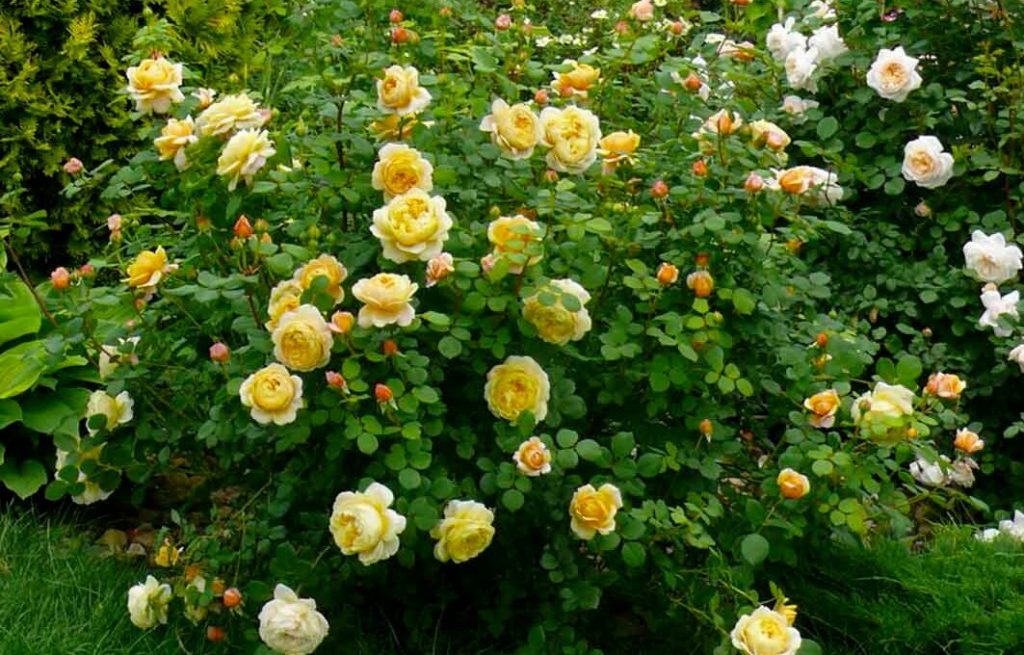
You can get more of a certain variety yourself, using the main types of reproduction:
- Cuttings - plant part of the shoot with buds (after spring pruning) in moist soil (greenhouse), use a rooter.
- Layers - a part of the lower branch is attached with a peg to the ground, sprinkled, left for 2-3 months, then cut off from an adult plant.
- Budding - an incision is made on the bark of the lower part, a part with a cultural kidney is inserted, experience is required.
Propagation of roses by seeds is not used due to poor germination of seeds, for a long time.
The easiest way is cuttings, when in good conditions (warmth and high humidity) the shoot gives roots.
Rating of the best varieties of Austin roses
New catalogs of the current year are considered. New "ostins" are different:
- color - from pale pink to dark crimson (there is a variant with a lemon yellow color);
- buds - from small to large, densely double;
- shape - simple, rosette, cup-shaped.
5th place: EUSTACIA VYE
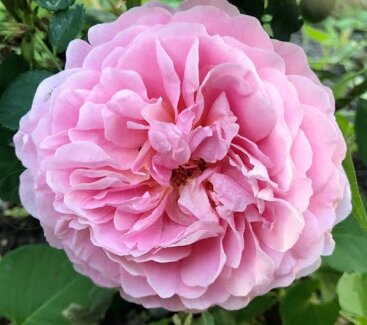
Eustacia Vai - the variety is named after the heroine of Thomas Hardy's book Homecoming.
Properties:
- pink, apricot shade;
- inflorescences - brushes;
- fruity smell;
- double flower;
- reddish stems;
- dimensions (cm): height - 110-120, width - 85-95.
The shape of the buds is rosette-shaped, the number of petals is 40-43, the diameter is 8-9 cm.
Wave-like type of flowering. The leaves are dull, dense. The branches are vertical, there are thorns. High resistance to disease, frost.
Can be planted along fences, combining with other plants.
- changing color from apricot to pale pink;
- fruity smell;
- rounded shape of the bush;
- can grow in partial shade;
- does not get sick.
- loose button.
4th place: Gabriel Oak
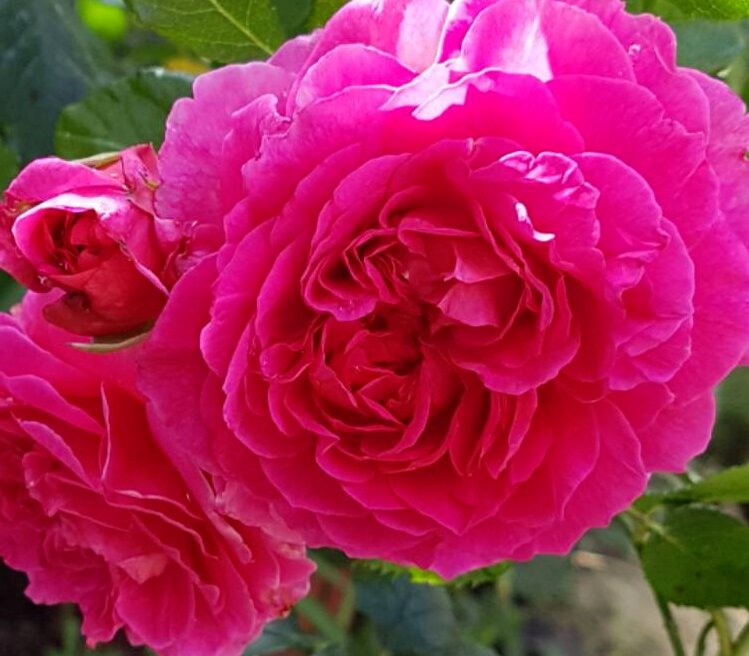
The name is in honor of the hero of the novel "Far from the Madding Crowd" by the English writer Thomas Hardy.
Peculiarities:
- dark pink, raspberry shades (fade over time);
- strong, fruity aroma;
- reddish, drooping shoots;
- bush dimensions (cm): height 120-130, width - 110-150.
Hustomahrovy flower, diameter - 8-10 cm, 50-55 petals.
The leaves are dark green, shiny. Branches with thorns, long, slightly inclined.
High resistance to diseases, winter conditions. Grows on all types of soils. Used for cutting, decorating fences, can grow in containers.
- beautiful interchangeable color;
- rounded shape of the bush;
- winters well;
- not sick;
- suitable for all types of soil.
- not found.
3rd place: Tottering By Gently
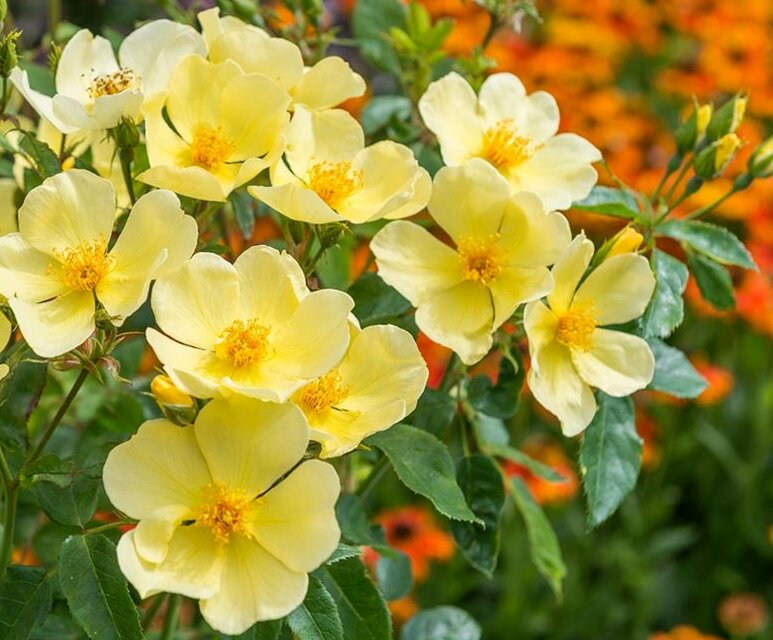
The variety is named in honor of the anniversary (25th anniversary of the release) of the Annie Tempest comic - the Tottering-by-Gently series (humorous incidents of members of the Tottering family).
Differences:
- single yellow flowers;
- simple form;
- aroma of musk, orange peel;
- inflorescences - brushes;
- bush size (cm): height - 135-140, width - 130-135;
- constant bloom.
The color of the petals fades with time, large stamens are visible in the center. The size of the buds is 5-8 cm.
Round shape of an adult plant. Rarely sick, well tolerated by medium frosts.
- many simple buds;
- soft color;
- medium aroma of citruses and musk;
- blooms all season.
- non-double buds.
2nd place: The Mill on The Floss
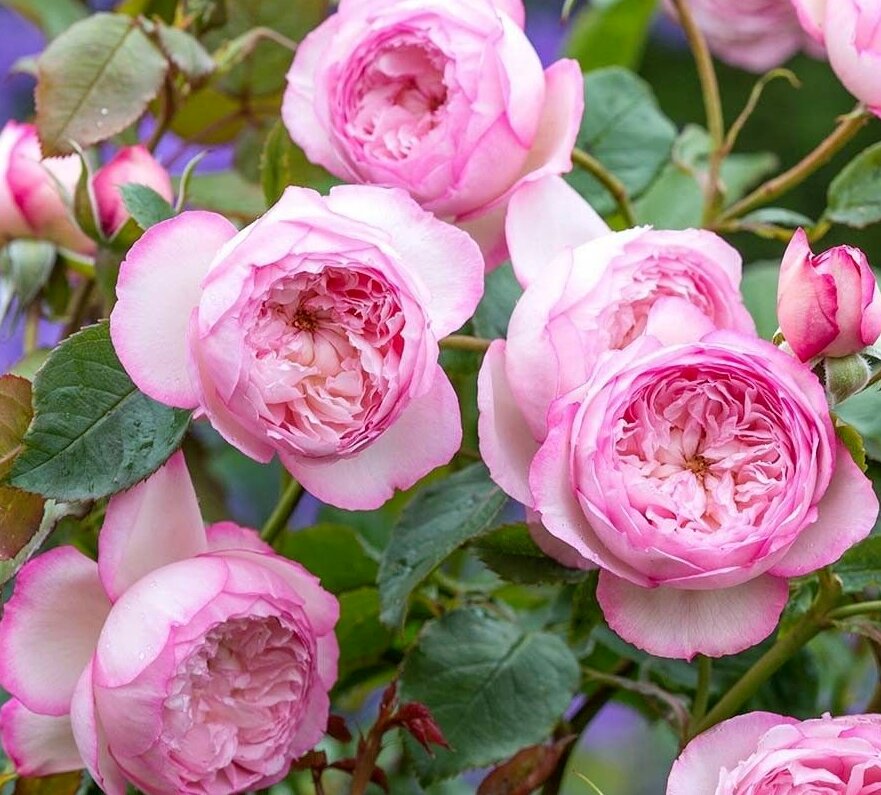
The title is inspired by George Eliot's novel The Mill on the Floss.
Peculiarities:
- flowers are pale pink, pale lilac, with a contrasting border;
- 6-10 pieces on one shoot;
- the branches bend a little;
- sweet fruity smell;
- dimensions (cm): height - 130-135, width - 110-120.
Differs in plentiful, continuous emergence of new buds. Leaves are not affected by diseases. There is a high resistance to frost, precipitation.
- gentle changeable shade;
- fruity smell;
- not sick;
- tolerates frost, rain;
- exuberant bloom.
- not found.
1st place: Emily Bronte
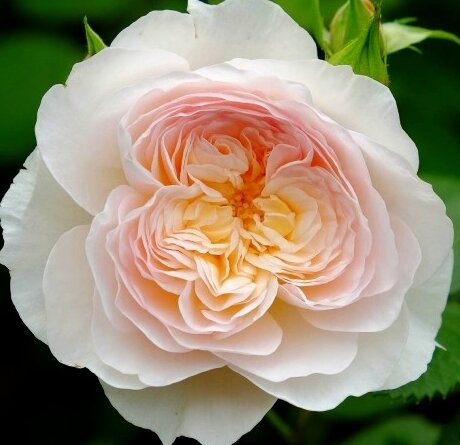
The name of the variety is the name of the English poetess, writer Emily Jane Bronte, in honor of the 200th anniversary of her birth.
Peculiarities:
- pink, apricot (central part) shades;
- the shape of the bud is a flat rosette;
- strong aroma (old tea varieties, citrus fruits - grapefruit, lemon);
- parameters of an adult plant (cm): height - 115-120, width - 100-105.
The flower is densely double, diameter - 10-12 cm. It is distinguished by immunity to diseases (powdery mildew, spotting), severe frosts.
- large sizes;
- delicate colors of different parts;
- strong smell;
- strong shoots;
- leaves are not affected by fungal diseases.
- not identified.
Popular varieties
The best-selling specimens, according to reviews among buyers of online plant stores, nurseries. The cost depends on the age of the plant (one-year-old, two-year-old seedling), the type of root system (ZKS - closed, OKS - open).
5th place: The Ainwick Rose
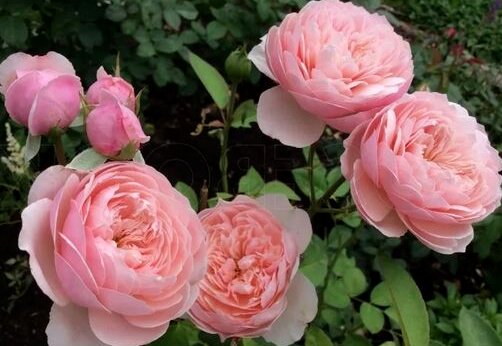
Price: 950 rubles.
The name comes from the rose garden at Alnwick Castle, created by the Duchess of Northumberland. Introduced in 2001.
Properties:
- rich pink shade fades over time;
- cupped shape;
- classic aroma of old roses, berry notes of raspberries;
- parameters (cm): height - 125-130, width - 75-80.
Gustomahrovy type, 115-125 petals, diameter - 7-9 cm. Middle - twisted yellowish small petals. Flowering is repeated throughout the season, until the first frost.
The foliage is thick and shiny. The shoots are strong, straight, the bush is vertical, rounded. used for micro-borders, single landings.
- beautiful color;
- dense type;
- pleasant berry smell;
- high immunity to fungal diseases.
- not identified.
4th place: TRADESCANT
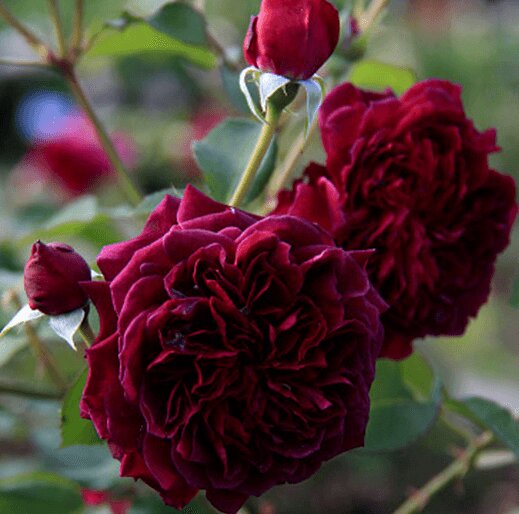
Cost: 450 rubles.
The Tradescant variety was bred in 1993. Differs in the darkest color, small sizes.
Properties:
- color from wine to dark purple;
- sweet aroma;
- forms brushes of 5-9 pieces;
- form - rosette-shaped;
- arched thin shoots;
- bush dimensions (cm): height - 75, width - 60.
Bud densely double, petals 60-100 pieces, diameter 6-7 cm. Small, soft spikes.
Flowering is repeated, all summer and autumn. Can be used as a climbing type in hot climates.
Planted in the foreground.
- rich dark color;
- does not fade in the bright sun;
- can be used as a climbing plant.
- slowly growing.
3rd place: WINCHESTER CATHEDRAL
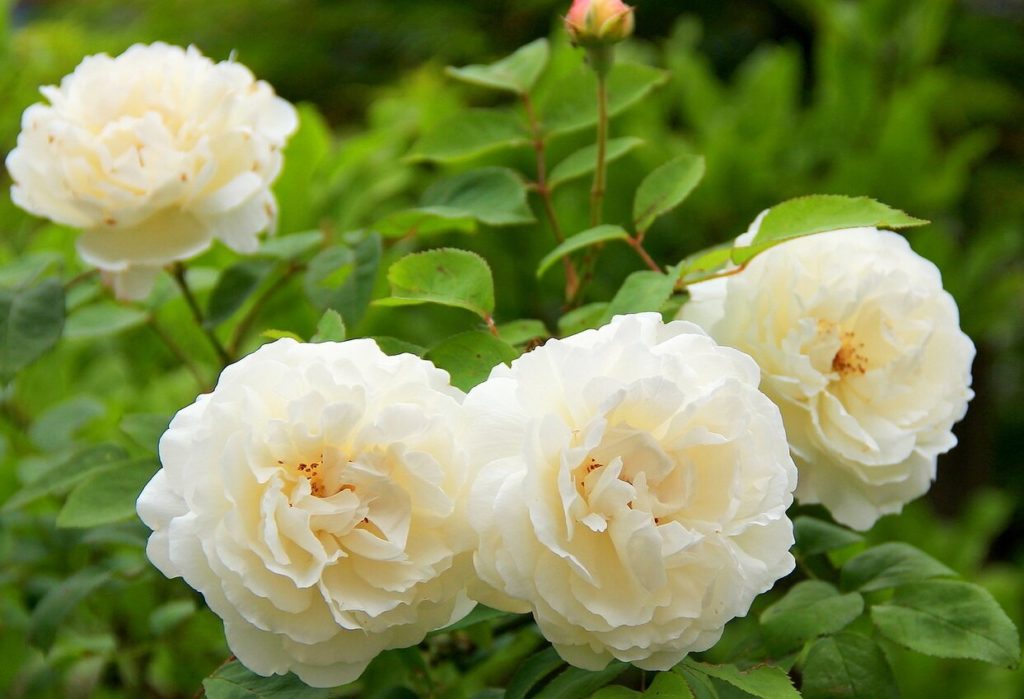
Price: 250-1.199 rubles.
The name is in honor of Winchester Cathedral. The variety was bred in 1984.
Peculiarities:
- white color;
- forms brushes of 3-5 pieces;
- aroma of honey, almonds;
- leaves are dull, dark green;
- winter hardiness - up to -23⁰С;
- medium sensitivity to powdery mildew, spotting;
- bush dimensions (m): height 1.1-1.2, width 1-1.2.
The flower is densely double, the number of petals is 55-60, the diameter is 7-10 cm.
Flowering - all summer, autumn. Suitable for growing in containers, in central locations. Cut plants stand in water for a long time.
- pleasant aroma;
- few spikes;
- no need for garters, supports;
- petals do not deteriorate in the bright sun.
- the first flowers after planting are loose.
2nd place: Olivia
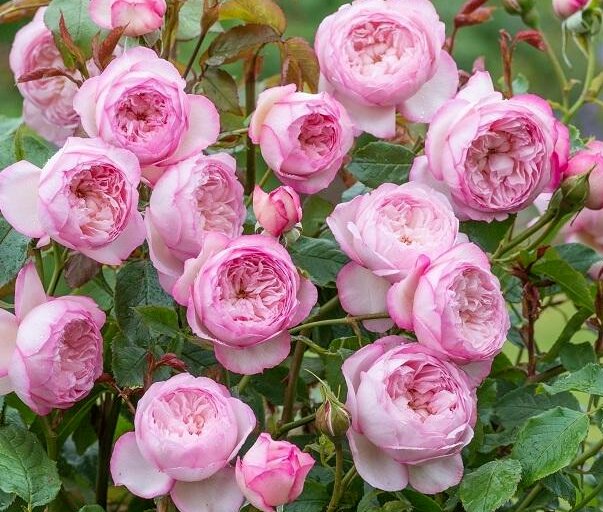
Cost: 1.599 rubles.
Rose Olivia is a scrub variety, bred in 2005, sold since 2014.
Properties:
- rose buds;
- shape - round rosette;
- fruity aroma;
- repeated flowering;
- high resistance to fungal diseases;
- frost resistance (zone 6 - up to -23⁰ С);
- plant dimensions (cm): height - 85-90, width 70-75.
The flower is terry, the number of petals is 40-50, the diameter is 8-9 cm. When fully opened, a yellow core is visible.
It is used in the design of borders, growing in containers, group compositions.
- pleasant fruity smell;
- not sick;
- does not freeze;
- compact dimensions.
- not found.
1st place: Falstaff
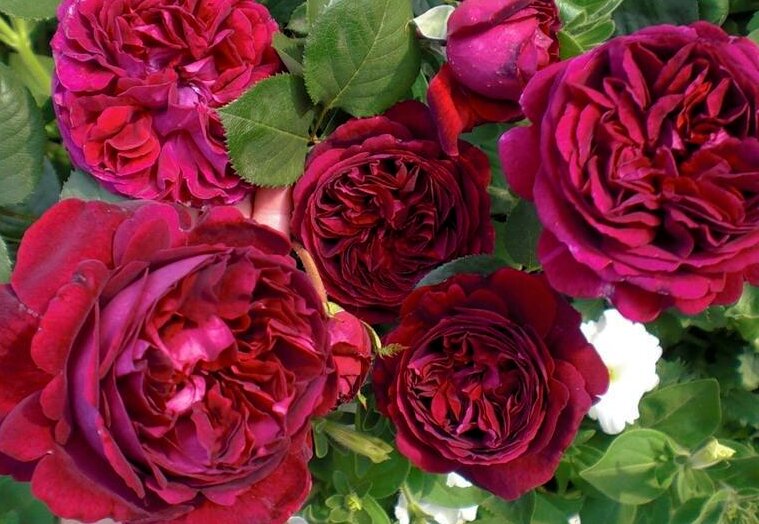
Price: 950-1.699 rubles.
Rose Falstaff is a group of spray roses. The variety was bred in 1999.
Seedlings with ZKS are on sale, age - 2 years.
Peculiarities:
- flower diameter - 10-11 cm;
- crimson-purple color of buds;
- re-blooming;
- bush dimensions (cm): height 100-140, width 80-90;
- strong resistance to precipitation;
- winter hardiness - up to -29⁰ С;
- high resistance to powdery mildew;
- medium - black spotting.
Opens buds in May. Continues to bloom June, July. The flower is densely double, the number of petals is 90-105.
Used for cutting, single or group compositions, hedges.
Suitable for central Russia, Moscow region. Wintering - shelter after frost -5⁰ -7⁰С.
- rich color, bud shape;
- blooms for a long time;
- growing fast;
- frost-resistant variety;
- buds do not deteriorate in the rain, high temperature.
- not found.
Conclusion
"Austinki" have different colors, a pronounced aroma, compact size. Considering the rating of the best varieties of Austin roses, you can choose a new favorite in your own garden, decorate the yard, ennoble the gazebo, make a gift to your loved one.
new entries
Categories
Useful
Popular Articles
-

Top ranking of the best and cheapest scooters up to 50cc in 2022
Views: 131652 -

Rating of the best soundproofing materials for an apartment in 2022
Views: 127693 -

Rating of cheap analogues of expensive medicines for flu and colds for 2022
Views: 124520 -

The best men's sneakers in 2022
Views: 124034 -

The Best Complex Vitamins in 2022
Views: 121941 -

Top ranking of the best smartwatches 2022 - price-quality ratio
Views: 114981 -

The best paint for gray hair - top rating 2022
Views: 113396 -

Ranking of the best wood paints for interior work in 2022
Views: 110320 -

Rating of the best spinning reels in 2022
Views: 105330 -

Ranking of the best sex dolls for men for 2022
Views: 104368 -

Ranking of the best action cameras from China in 2022
Views: 102217 -

The most effective calcium preparations for adults and children in 2022
Views: 102012



